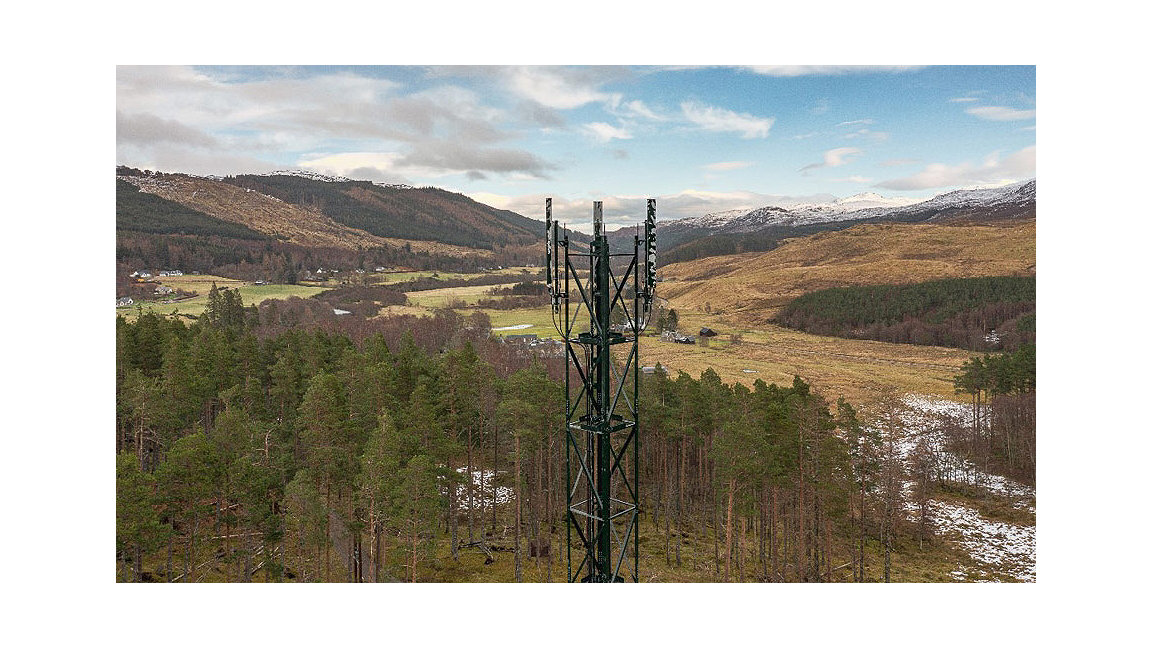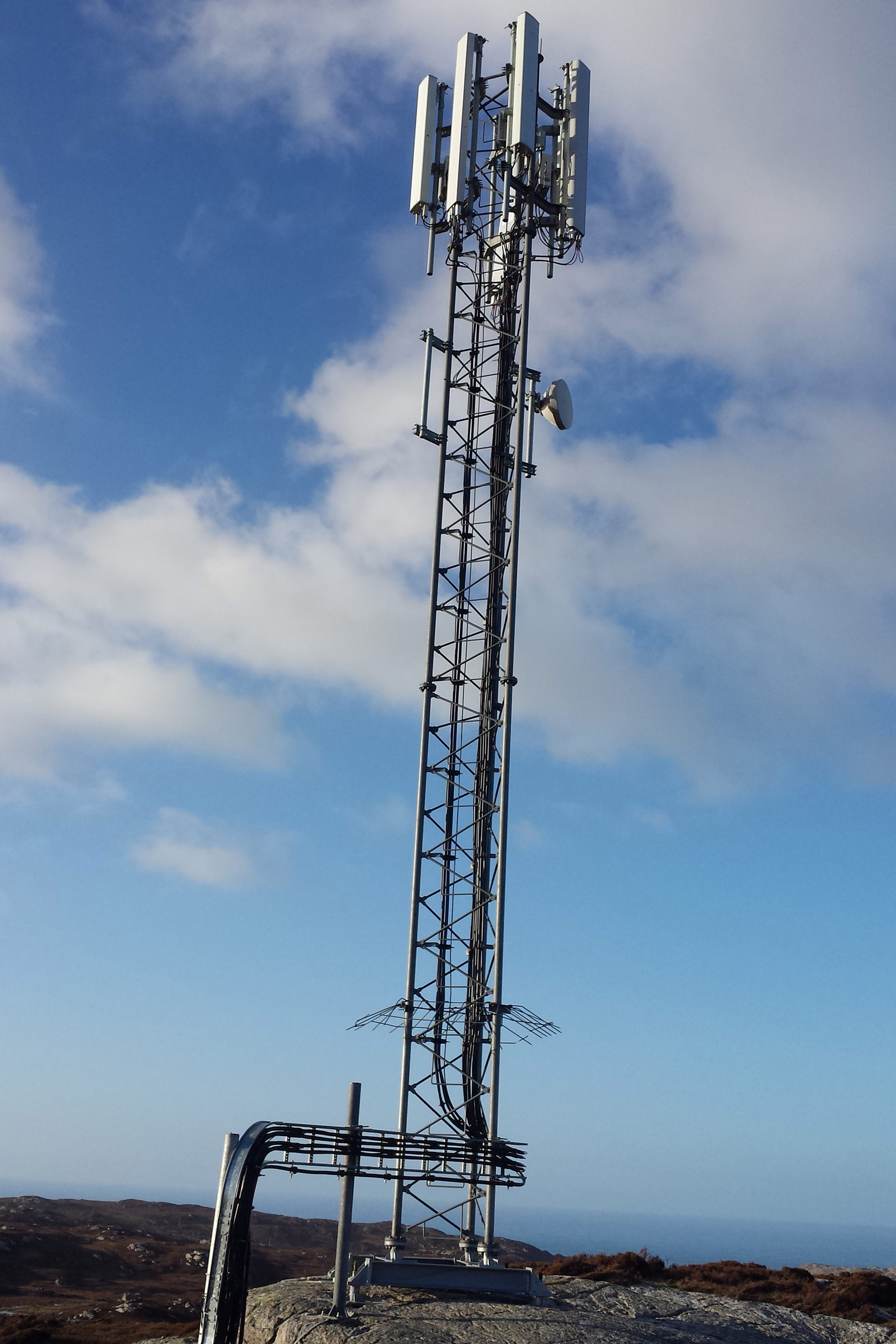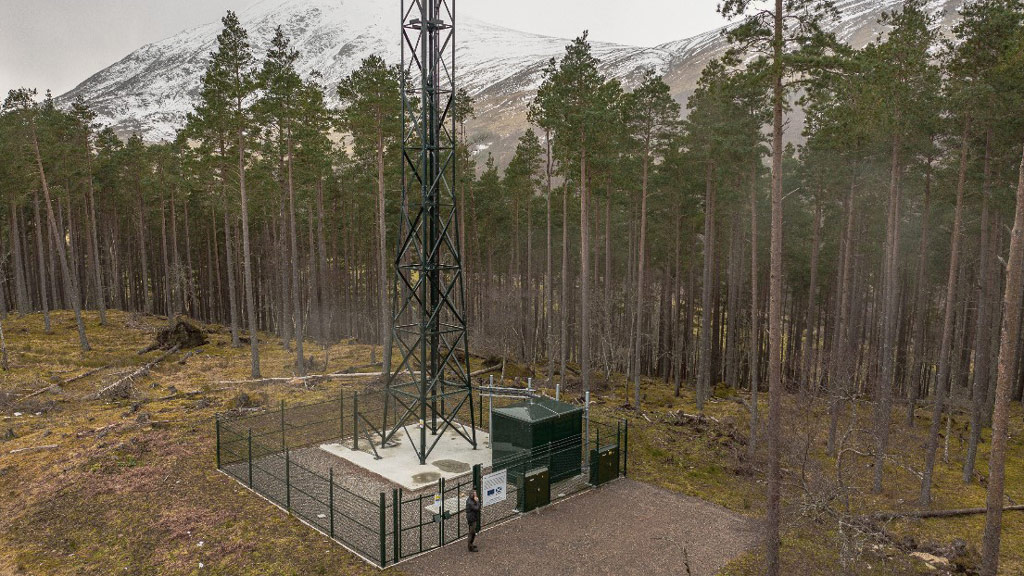
Strathconon mast head frame, © SFT
The Scottish 4G Infill (S4GI) programme represents a £25m investment to improve mobile connectivity in rural areas where there is no coverage from any operator. The programme is largely funded by the Scottish government, with £10m of European funding support from the European Rural Development Funding (ERDF) for the Highlands and Islands intervention area.
When complete, it will provide 4G mobile infrastructure and services for up to 40 so-called not spots. The programme is a vital part of the government's digital connectivity portfolio, which is installing critical national infrastructure to help Scotland's green economic and social recovery from COVID-19.
Meanwhile, work on the Reaching 100% programme – which is providing superfast broadband connections to Scottish addresses that remain hard to reach – is also under way. Together, these programmes will provide the backhaul – a high capacity fibre connection linking a remote site to another site – and core infrastructure required to give all homes and businesses better connectivity and affordable digital communications.
Cooperating with the operators
Scottish Futures Trust (SFT) is managing the S4GI programme, and is building on the knowledge and experience it gained on the successful deployment of a community-owned mast on the Isle of Coll in 2014, when it collaborated with Vodafone.

A second community mast was deployed on the Isle of Arran, in collaboration with O2, in 2016. Since then, 4G services from Vodafone, O2 and BT EE have been available to residents and businesses.
This early success, together with increasing demand for mobile connectivity to reduce the digital divide encouraged the Scottish government to design and create the nation's first Mobile Action Plan in 2016.
To help get S4GI off the ground, engagement with the telecoms sector began in 2017. This was a chance for SFT to liaise with mobile operators, wireless infrastructure providers, the Home Office and the Department for Digital, Culture, Media & Sport (DCMS) to gauge potential interest and share lessons learned.
- The adoption of an industry-based deployment process, with simplified progress and payment milestones.
- Single mobile operator anchor tenancy. As part of the grant agreement with the infrastructure provider, at least 1 mobile operator must commit to using the mast before it can be built. This reduces the risk of building a mast that stands empty after it's been built which, in turn, reduces the risk of spending public funding unnecessarily.
- A multi-operator infrastructure site design that must be future proofed. This involves the mast, power and backhaul being able to accommodate multiple users, such as mobile operators, community groups or others to minimise future upgrade work at the site.
- Business rate support.
- Fibre to the mast wherever possible. Fibre backhaul provides a future-proofed connection that can be used by multiple users requiring high speed connectivity. Products running over the fibre can be easily upgraded to support higher capacity connections that will be required in future as more "data hungry" services are introduced via 4G and future 5G mobile coverage.
- Before the procurement approach was agreed, SFT had to agree a state aid route with Scottish government that enabled the public funding to be used in a way that would not distort competition and trade in the European Union (EU).This was given ministerial approval at the end of 2017.
Programme progress
In July 2018 infrastructure provider WHP Telecoms Ltd was appointed, and the programme launched officially in October after the government delegated authority to SFT to act as its programme manager. This included spending within agreed levels, and setting up a programme board that had representation from external Scottish stakeholders such as Highland & Islands Enterprise, Federation of Small Businesses and Cell:CM that would benefit from the resulting infrastructure, 4G coverage and service.
- 14 sites in the acquisition stage
- 9 sites are under construction
- 17 sites are awaiting installation and commissioning
- 6 live sites at Ettrick, New Luce, Blairmore, Little Mill, Selivoe and Strathconon
- more than 200km of fibre laid
- 1 planning refusal in Pennan, where councillors refused the application for an 8m mast last year.

The team – myself, the programme manager and deployment assurance manager – will continue to share best practice and work closely with government organisations to encourage and facilitate further investment to extend rural coverage across Scotland.
All SG4I sites are being assessed for future deployment and alignment with the DCMS-funded Shared Rural Network (SRN) as well. SRN is an agreement between DCMS and all mobile operators to "deliver reliable mobile broadband to 95% of the UK, addressing the digital divide by improving 4G coverage in the areas that need it most." As an existing mobile infrastructure programme, S4GI will act as a blueprint to help shape the SRN team's approach to its considerably larger UK-wide intervention.
Once the UK's 4G not spots are identified, a suitable procurement approach must be discussed with SRN's clients, in this case the mobile operators and DCMS. The right balance must be struck between the way new SRN sites are deployed and mast deployment processes to ensure they meet the EU requirements for using public funding.
As a result, the procurement approach should be compliant with EU state aid provisions, once the new sites' ongoing operational costs have been included. The SRN programme can then start deploying its new masts, where further collaboration across the government, local communities and industry will be key to success.
Code considerations
There have been many deployment challenges to overcome before sites go live. The revised Electronic Communications Code (ECC) has had a significant impact on managing landowners' expectations at the site acquisition and design stage. Professionals wishing to know more can consult Surveyors advising in respect of the Electronic Communications Code guidance note, 1st edition.
This is particularly evident when the programme has dealt with owners of large estates who have agreements under the old code that had to be renegotiated on other parts of their estate in line with the new version resulting in lower rental values. In more remote areas, this often involves lengthy discussions with multiple parties.
- radio coverage planning which uses a software tool to predict the 4G coverage footprint from a specific location taking into consideration the height of the mast and the planned radio frequencies – and radiating power – against the geographic topology of the surrounding landscape
- proximity of power and fibre-optic data connections
- land access
- planning authority consent.
The build phase is the start of the construction process which includes casting the concrete base, if required, because some of the masts are rock anchored – building the access track if required, compound fencing, ducting, meter cabinets, erecting the mast, arranging power and fibre backhaul.
From a build perspective, the main challenge has been ensuring that the programme has the appropriate national and local supply chain and logistics to deliver the right resources and equipment to remote locations across Scotland. Because the programme depends on ferry and light aircraft services to reach remote rural or island locations, the nation's temperamental weather can have an adverse impact by delaying site logistics and slowing down the lead time for third-party fibre and power providers.
COVID-19 has also had an impact on site deployment, and activity over summer 2020 was limited by government restrictions. Since then, the programme has made significant progress and is on track to complete work on more sites in the coming months.
As we enter winter, the S4GI team's ongoing work will start reaping its rewards. In collaboration with the anchor mobile operators, further sites are due for activation, meaning more rural communities benefit from good-quality 4G coverage for the first time.
With average 4G download and upload speeds of 35Mbps and 10Mbps respectively, the advent of the SRN and the continued roll-out of the S4GI programme will mean more remote communities across Scotland start to enjoy local coverage, and see the lasting benefits in the years to come.
